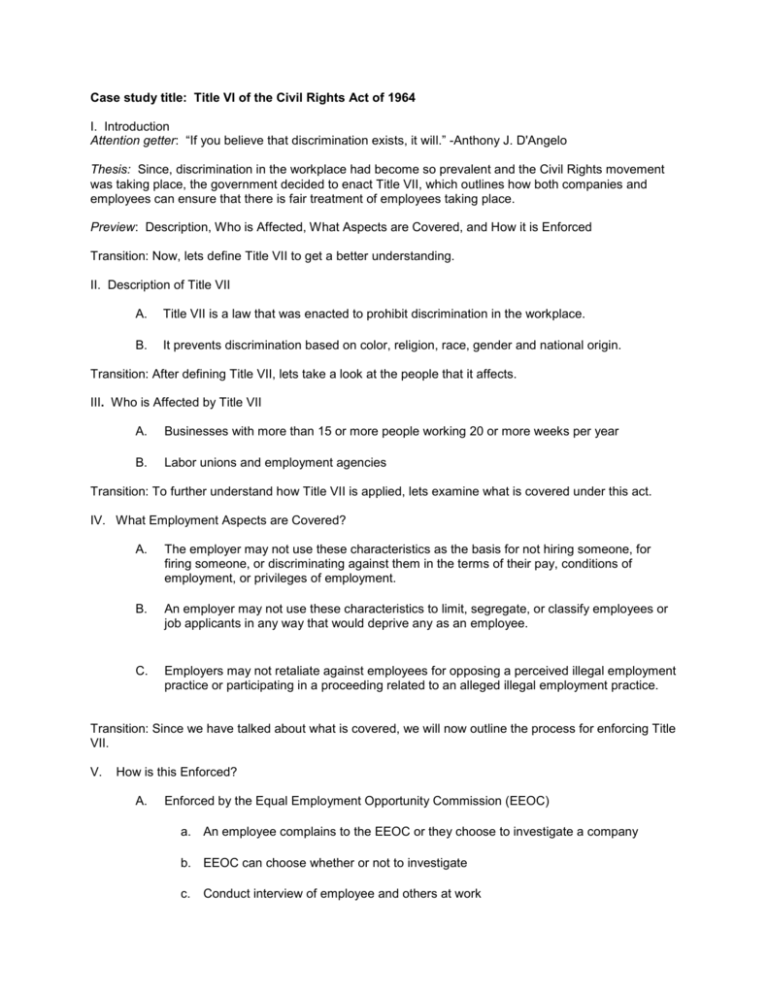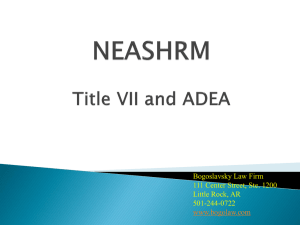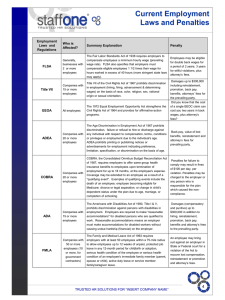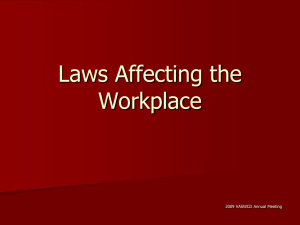ACT Outlines - De Anza College
advertisement

Case study title: Title VI of the Civil Rights Act of 1964 I. Introduction Attention getter: “If you believe that discrimination exists, it will.” -Anthony J. D'Angelo Thesis: Since, discrimination in the workplace had become so prevalent and the Civil Rights movement was taking place, the government decided to enact Title VII, which outlines how both companies and employees can ensure that there is fair treatment of employees taking place. Preview: Description, Who is Affected, What Aspects are Covered, and How it is Enforced Transition: Now, lets define Title VII to get a better understanding. II. Description of Title VII A. Title VII is a law that was enacted to prohibit discrimination in the workplace. B. It prevents discrimination based on color, religion, race, gender and national origin. Transition: After defining Title VII, lets take a look at the people that it affects. III. Who is Affected by Title VII A. Businesses with more than 15 or more people working 20 or more weeks per year B. Labor unions and employment agencies Transition: To further understand how Title VII is applied, lets examine what is covered under this act. IV. What Employment Aspects are Covered? A. The employer may not use these characteristics as the basis for not hiring someone, for firing someone, or discriminating against them in the terms of their pay, conditions of employment, or privileges of employment. B. An employer may not use these characteristics to limit, segregate, or classify employees or job applicants in any way that would deprive any as an employee. C. Employers may not retaliate against employees for opposing a perceived illegal employment practice or participating in a proceeding related to an alleged illegal employment practice. Transition: Since we have talked about what is covered, we will now outline the process for enforcing Title VII. V. How is this Enforced? A. Enforced by the Equal Employment Opportunity Commission (EEOC) a. An employee complains to the EEOC or they choose to investigate a company b. EEOC can choose whether or not to investigate c. Conduct interview of employee and others at work d. EEOC works out settlement between employee and business through reconciliation. It is an informal process outlining the steps to remedy basis of complaint i. If agreed upon, employee has to give up right to sue e. If no agreement reached, EEOC gives right-to-sue letter i. Letter does not mean EEOC supports employee’s claim of discrimination Transition: We would now like to summarize how Title VII affects employees, whom it covers, and how it is enforced. VI. Conclusion Review: As part of the Civil Rights Act, the government made sure that discrimination would no longer take place in the workplace based on color, religion, race, gender and national origin. In reaction to this Act the EEOC was formed to ensure that these laws are upheld and protect the employees of organizations. Final thought: “How I wish we lived in a time when laws were not necessary to safeguard us from discrimination.” -Barbra Streisand Outline – Americans with Disabilities I. Introduction A. Attention getter: Did you know that 1 out of every 5 Americans has some kind of disability? And that many other people do not report their disabilities at all? According to the US Census Bureau, 35 million Americans are severely disabled. Out of those that are severely disables, 31% are employed. Out of those with non severe disabilities 75% are employed. B. Thesis: The Americans with Disabilities Act of 1990 (ADA) prohibits discrimination against individuals with disabilities. C. Preview: Today we will cover the description of the act, as well as who is affected by this act, what employment aspects are covered and how is it enforced. II. Description of the act A. The ADA of 1990 is a wide range law that prohibits under certain circumstances to discriminate individuals based on disability. Disability is defined as a physical or mental impairment that substantially limits a major life activity. B. Includes 5 titles that deal with the following: Title I- Employment: Title II- Public Entities Title III- Public Accommodation Title IV- Telecommunication Title V – Miscellaneous Provisions Transition: Now that we have described the act, we will cover who is affected by it. III. Who is affected A. Who is affected by it? Serious disabilities: A. Blindness, deafness or paralysis This affects their abilities to perform major tasks such as walking, seeing, performing manual tasks and learning. History of disabilities: A. Cancer: but in recovery mood, mental illness and history of heart disease. Being regarded as having a disability. A. Employer might be hesitating to hire such people because people will act negatively towards them Transition: Now that we have described who is affected by this act, we will explain what employment aspects are covered. IV. What employment aspects are covered A. Hiring 1. Employment Practices (training, compensation, job task, etc.) Have an equal opportunity to apply for jobs and to work in jobs for which they are qualified; Have an equal opportunity to be promoted Have equal access to benefits and privileges of employment that are offered to other employees; and are not harassed because of their disability. 2. Reasonable Accommodations Ensuring that recruitment, interviews, tests, and other components of the application process are held in accessible locations Providing or modifying equipment or devices Adjusting or modifying application policies and procedures. B. Performance 1. An employer generally does not have to provide a reasonable accommodation unless an individual with a disability has asked for one. 2. If an employer believes that a medical condition is causing a performance or conduct problem, it may ask the employee how to solve the problem and if the employee needs a reasonable accommodation. 3. Once a reasonable accommodation is requested, the employer and the individual should discuss the individual's needs and identify the appropriate reasonable accommodation. 4. Where more than one accommodation would work, the employer may choose the one that is less costly or that is easier to provide Transition: Now that we explained what employment aspects are covered we will Describe how this ace is enforced. V. How is this act enforced A. The Department of Justice enforces the ADA's requirements in three areas: Title I: Employment practices by units of State and local government Title II: Programs, services, and activities of State and local government Title III: Public accommodations and commercial facilities B. Enforcement Through lawsuits and both formal and informal settlement agreements, the Department has achieved greater access for individuals with disabilities in thousands of cases. Under general rules governing lawsuits brought by the Federal Government, the Department of Justice may not file a lawsuit unless it has first unsuccessfully attempted to settle the dispute through negotiations C. Litigation VI. The Department may file lawsuits in Federal court to enforce the ADA and may obtain court orders including compensatory damages and back pay to remedy discrimination. Under title III the Department may also obtain civil penalties of up to $55,000 for the first violation and $110,000 for any subsequent violation. Conclusion A. Summary Today we have discussed the ADA of 1990 and we have talked about who is affected by this act, what employment aspects are covered and how this act is enforced. B. The ADA of 1990 prohibits discrimination against individuals with disabilities. C. When making hiring decisions, employers have to be conscious of how to handle employment and disability issues carefully in order to avoid legal matters in the future. Immigration Reform and Control Act of 1986 I. Introduction and outline A. The prospect of employment, is an economic magnet that draw both legal and immigrants to the United States in record numbers illegal II. Origin and History of the Immigration Reform and Control Act of 1986 A. Mazzoli and Simpson 1. Simpson-Mazzoli Act B. Inception of New Hiring Practices (That’s the basic history of the IRCA, now Paige will tell us whom it affects and how…) III. Affects A. Employees 1. Documentation 2. Legal Requirements B. Employers 1. Applications 2. Legal Responsibilities C. Labor Market 1. Subcontractors 2. Discrimination (Transition Sentence: Now that we understand whom the IRCA effects, Queen will talk about what aspects of Employment this act covers…) IV. Employment aspects covered: A. Legal hiring 1. I-9 B. Forms of legal working status 1. F1 student visa 2. H1b visa C. Homeland Security 1. Background check 2. Agreement with application information (Next, Brian will talk about, how the IRCA is enforced…) V. Enforcement A. U.S. Citizenship and Immigration Services 1. Formerly INS 2. Homeland Security B. Sanctions 1. Penalties 2. Criminal Prosecution D. Additional Info 1. Options for existing workers. 2. Increased usage of "subcontractors" 3. Temporary Work Visas provided if employers can demonstrate lack of available work VI. Summary and Conclusion A. Compliance with the IRCA is critical as we experience more and more into the U.S. immigration Case Study Outline: Genetic information Nondiscrimination Act of 2008 I. Intro A. Hook 1. The late Senator Ted Kennedy applauded GINA as "the first civil rights bill of the new century of the life sciences." B. Thesis 1. The Genetic Information Nondiscrimination Act of 2008 (GINA), is designed to prohibit the improper use of genetic information in health insurance and employment. C. Preview 1. This presentation provides a description/summary, states who is affected, answers what employment aspects are covered and describes who enforces The Genetic Information Nondiscrimination Act. (Rediet) will now provide a description/summary of The Genetic Information Nondiscrimination Act II. Description A. The Genetic Information Nondiscrimination Act of 2008, also referred to as GINA, is a new Federal law that prohibits discrimination in health coverage and employment based on genetic information. 1. The statute defines ‘genetic test’ as an analysis of human DNA, RNA, chromosomes, proteins, or metabolites that detects genotypes, mutations, or chromosomal changes. B. Title I prohibits group health plans and health insurers from denying coverage to a healthy individual or charging that person higher premiums based solely on a genetic predisposition to developing a disease in the future. C. Title II of GINA outlines unlawful activities for an employer, employment agency, labor organization, or training program in the use of genetic information. ( Kehri ) will now go over who is affected. III. Who is affected A. Title I 1. Current insurance receivers 2. Future insurance receivers B. Title II 1. Current employees 2. Future employees C. Excluded 1. GINA will not be retroactive, i.e., it cannot apply to acts or omissions that occurred prior to GINA’s effective dates. D. Personal example. ( Natasha) will now give an account of what employment aspects are covered in The Genetic Information Nondiscrimination Act IV. What employment aspects are covered A. An employer may not use genetic information in making decisions regarding hiring, promotion, terms or conditions, privileges of employment, compensation, or termination. B. An employer may not limit, segregate, or classify an employee or deprive that employee of employment opportunities, on the basis of genetic information. C. An employer may not request, require, or purchase genetic information of the individual or a family member of the individual except in rare cases D. An employment agency may not fail or refuse to refer an individual for employment on the basis of genetic information, nor attempt to cause an employer to discriminate against an individual on the basis of genetic information. E. An employer may not use genetic information in making decisions regarding admission to or employment in any program for apprenticeship or training and retraining, including on-the-job training. F. A labor organization may not exclude or expel from membership, or otherwise discriminate against an individual because of genetic information. (Kehri ) will now describe how The Genetic Information Nondiscrimination Act is enforced. V. How is this enforced A. Title I 1. The Department of Labor, the Department of the Treasury, and the Department of Health and Human Services B. Title II 1. The Equal Employment Opportunity Commission (EEOC) 2. Individuals may also have the right to pursue private litigation. 3. Remedies for violations include corrective action and monetary penalties. ( Mat) will now summarize the presentation and we will all take questions. VI. Conclusion A. The Genetic Information Nondiscrimination Act protects all Americans by: Prohibiting insurers in both the group and individual health insurance market from requesting or requiring genetic testing of an individual or his family or using genetic information to determine eligibility or establish premiums. It also prohibits employers, including employment agencies and labor organizations, from requesting or requiring genetic testing of an individual or his family or using genetic information to make hiring or promotional decisions, or when determining eligibility for training programs. B. An overwhelming majority of Americans (85%) believe that if someone has a genetic test, their employer should not have the right to know the results. Republicans, Democrats, and individuals from all racial and ethnic groups, religions, and income and education levels share this opinion. [Survey conducted in 2002 by the Genetics and Public Policy Center, Johns Hopkins University.] Case study title: The Age Discrimination in Employment Act 1967 (ADEA) I. Introduction: Attention getter: “Discrimination due to age is one of the great tragedies of modern life. The desire to work and be useful is what makes life worth living, and to be told your efforts are not needed because you are the wrong age is a crime.” Johnny Ball Thesis: The ADEA was enacted to protect employees against unfair discrimination due to their age (40+). Preview: Today we will be discussing the ADEA including its description, who’s affected, the employment aspects covered, and how it is enforced. Transition: First Alma will be giving us a detailed description of the ADEA. II. Description of Act: The Age Discrimination in Employment Act (ADEA) is the federal law governing age discrimination. It was enacted in 1967 to promote the employment of older workers based on ability rather than age, prevent discrimination, and help solve the problems that arise with an aging workforce. Many states also have laws prohibiting age discrimination and may have more restrictions than the ADEA. ADEA protections include: 1. Apprenticeship Programs It is generally unlawful for apprenticeship programs, including joint labor-management apprenticeship programs, to discriminate on the basis of an individual’s age. Age limitations in apprenticeship programs are valid only if they fall within certain specific exceptions under the ADEA or if the EEOC grants a specific exemption. 2. Job Notices and Advertisements The ADEA generally makes it unlawful to include age preferences, limitations, or specifications in job notices or advertisements. A job notice or advertisement may specify an age limit only in the rare circumstances where age is shown to be a “bona fide occupational qualification” (BFOQ) reasonably necessary to the normal operation of the business. 3. Pre-Employment Inquiries The ADEA does not specifically prohibit an employer from asking an applicant’s age or date of birth. However, because such inquiries may deter older workers from applying for employment or may otherwise indicate possible intent to discriminate based on age, requests for age information will be closely scrutinized to make sure that the inquiry was made for a lawful purpose, rather than for a purpose prohibited by the ADEA Transition: Next Russell will be detailing who is affected by the Act. III. Who is Affected: Covered ADEA forbids age discrimination against people who are 40 or older. Not illegal to favor an older worker over a younger one. Discrimination can occur when the victim and the person who inflicted the discrimination are both over 40. No limits for age. All workers 40 and older are protected. All U.S. citizens employed by U.S. companies have same broad protections against discrimination even when working in foreign countries. The protections travel with them. Not Covered It does NOT protect those under the age of 40, although some states do have laws that protect younger workers from age discrimination. People not employed by employer, independent contractors Who qualifies as an Employer under the ADEA? Every individual, partnership, association, labor organization, corporation or group of organized individuals who are: - engaged in industry affecting commerce - have 20 or more employees - have an employment relationship with the claimed employee Exceptions “bona fide executives” or “high policymakers” (i.e. an employer can impose retirement on any employee 65 or older) who is a “bona fide executive” or high policymaker” Transition: Lenard will now discuss what employment aspects are covered under the Act. IV. What Employment Aspects are Covered: The Age Discrimination in Employment Act prohibits an employer from refusing to hire, firing, or otherwise discriminating against an employee age 40 or older, solely on the basis of age. Thus, an employer can't deny an employee pay or fringe benefits when the only justification is age. Nor may an employer classify employees into groups on the basis of age in a way that unfairly deprives workers of employment opportunities. For example, an employer may not relegate all older workers to a particular level of employment within a company and then decline to promote them. In 1990, Congress further extended the reach of the Age Discrimination in Employment Act by passing the Older Workers Benefit Protection Act (OWBPA) as a way to further ensure that worker benefits were further protected from age discrimination. As is the case with all forms of discrimination, retaliating against an employee who files an age discrimination charge is unlawful under the ADEA. After an employee has filed a charge or complaint against his employer, whether internally or with an outside agency -- such as the Equal Employment Opportunity Commission (EEOC) -- or court, the employer should refrain from taking any action against the employee that might be construed as retaliation. Transition: Lastly Susie will talk about how the Act is enforced. V. How is the Act Enforced: EEOC enforces by: o Investigating and Inspecting and requires keeping records o Gathering information The complaining party's name, address, and telephone number; The name, address, and telephone number of the respondent employer, employment agency, or union that is alleged to have discriminated, and number of employees (or union members), if known; A short description of the alleged violation (the event that caused the complaining party to believe that his or her rights were violated); and The date(s) of the alleged violation(s). o Issues guidelines. A charge must be filed with EEOC within 180 days from the date of the alleged violation, in order to protect the charging party's rights. This 180-day filing deadline is extended to 300 days if the charge also is covered by a state or local anti-discrimination law. For ADEA charges, only state laws extend the filing limit to 300 days. These time limits do not apply to claims under the Equal Pay Act, because under that Act persons do not have to first file a charge with EEOC in order to have the right to go to court. However, since many EPA claims also raise Title VII sex discrimination issues, it may be advisable to file charges under both laws within the time limits indicated. o Resolving complaints o Waiver can be used to avoid legal action if the individual signed it knowingly and willingly Ex: Individual is let go from a job and offered early retirement incentive, usually sign a waiver to avoid legal action in the future. Transition: Now that we have outlined what the ADEA encompasses lets review the key points that we covered today. VI. Conclusion Review: The ADEA was enacted in 1967 to protect employees 40 and older against unfair descrimination. It protects employees age 40 and older. There is no limit on age. Does not protect those under the age of 40. All aspects of hiring, firing, and descrimination solely based on their age (40+) It is enforced by the EEOC and is investigated and taken seriously at the judicial level. Final thought: According to an Equal Employment Opportunity Commission (EEOC) announcement, 93,277 workplace discrimination charges, the second highest level of charges ever filed with the agency, were filed in 2009. The second highest number of age discrimination charges on record. Stuart J. Ishimaru, the EEOC’s acting chairman encouraged employers to “step up their efforts to foster discrimination-free and inclusive workplaces, or risk enforcement and litigation by the EEOC.”








